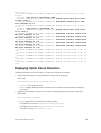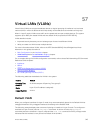
57
Virtual LANs (VLANs)
Virtual LANs (VLANs) are a logical broadcast domain or logical grouping of interfaces in a local area
network (LAN) in which all data received is kept locally and broadcast to all members of the group.
When in Layer 2 mode, VLANs move traffic at wire speed and can span multiple devices. The system
supports up to 4093 port-based VLANs and one default VLAN, as specified in IEEE 802.1Q.
VLANs benefits include:
• Improved security because you can isolate groups of users into different VLANs
• Ability to create one VLAN across multiple devices
For more information about VLANs, refer to the IEEE Standard 802.1Q Virtual Bridged Local Area
Networks. In this guide, also refer to:
• Bulk Configuration in the Interfaces chapter.
• VLAN Stacking in the Service Provider Bridging chapter.
For a complete listing of all VLAN configuration commands, refer to these Dell Networking OS Command
Reference Guide chapters:
• Interfaces
• 802.1X
• GARP VLAN Registration Protocol (GVRP)
• Service Provider Bridging
• Per-VLAN Spanning Tree Plus (PVST+)
The following table lists the defaults for VLANs in the system.
Feature
Default
Spanning Tree
group ID
All VLANs are part of Spanning Tree group 0.
Mode Layer 2 (no IP address is assigned).
Default VLAN ID VLAN 1
Default VLAN
When you configure interfaces for Layer 2 mode, they are automatically placed in the Default VLAN as
untagged interfaces. Only untagged interfaces can belong to the Default VLAN.
The following example displays the outcome of placing an interface in Layer 2 mode. To configure an
interface for Layer 2 mode, use the switchport command. As shown in bold, the switchport
command places the interface in Layer 2 mode and the show vlan command in EXEC privilege mode
indicates that the interface is now part of the Default VLAN (VLAN 1).
Virtual LANs (VLANs)
913


















